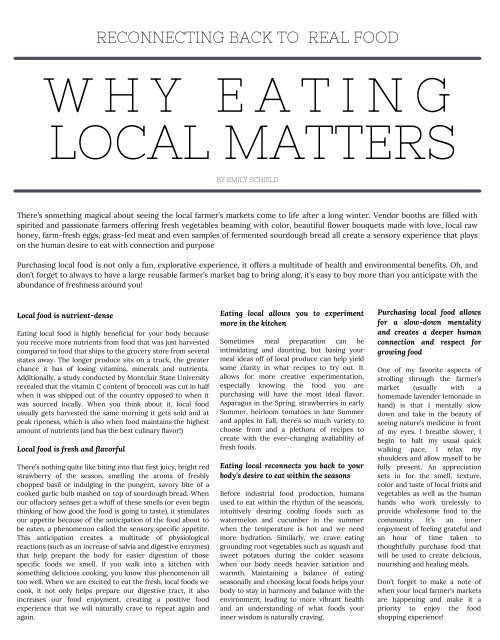Shores Summer 2022
You also want an ePaper? Increase the reach of your titles
YUMPU automatically turns print PDFs into web optimized ePapers that Google loves.
RECONNECTING BACK TO REAL FOOD<br />
W H Y E A T I N G<br />
LOCAL MATTERS<br />
BY EMILY SCHIELD<br />
There’s something magical about seeing the local farmer’s markets come to life after a long winter. Vendor booths are filled with<br />
spirited and passionate farmers offering fresh vegetables beaming with color, beautiful flower bouquets made with love, local raw<br />
honey, farm-fresh eggs, grass-fed meat and even samples of fermented sourdough bread all create a sensory experience that plays<br />
on the human desire to eat with connection and purpose<br />
Purchasing local food is not only a fun, explorative experience, it offers a multitude of health and environmental benefits. Oh, and<br />
don’t forget to always to have a large reusable farmer’s market bag to bring along, it’s easy to buy more than you anticipate with the<br />
abundance of freshness around you!<br />
Local food is nutrient-dense<br />
Eating local food is highly beneficial for your body because<br />
you receive more nutrients from food that was just harvested<br />
compared to food that ships to the grocery store from several<br />
states away. The longer produce sits on a truck, the greater<br />
chance it has of losing vitamins, minerals and nutrients.<br />
Additionally, a study conducted by Montclair State University<br />
revealed that the vitamin C content of broccoli was cut in half<br />
when it was shipped out of the country opposed to when it<br />
was sourced locally. When you think about it, local food<br />
usually gets harvested the same morning it gets sold and at<br />
peak ripeness, which is also when food maintains the highest<br />
amount of nutrients (and has the best culinary flavor!)<br />
Local food is fresh and flavorful<br />
There’s nothing quite like biting into that first juicy, bright red<br />
strawberry of the season, smelling the aroma of freshly<br />
chopped basil or indulging in the pungent, savory bite of a<br />
cooked garlic bulb mashed on top of sourdough bread. When<br />
our olfactory senses get a whiff of these smells (or even begin<br />
thinking of how good the food is going to taste), it stimulates<br />
our appetite because of the anticipation of the food about to<br />
be eaten, a phenomenon called the sensory specific appetite.<br />
This anticipation creates a multitude of physiological<br />
reactions (such as an increase of salvia and digestive enzymes)<br />
that help prepare the body for easier digestion of those<br />
specific foods we smell. If you walk into a kitchen with<br />
something delicious cooking, you know this phenomenon all<br />
too well. When we are excited to eat the fresh, local foods we<br />
cook, it not only helps prepare our digestive tract, it also<br />
increases our food enjoyment, creating a positive food<br />
experience that we will naturally crave to repeat again and<br />
again.<br />
Eating local allows you to experiment<br />
more in the kitchen<br />
Sometimes meal preparation can be<br />
intimidating and daunting, but basing your<br />
meal ideas off of local produce can help yield<br />
some clarity in what recipes to try out. It<br />
allows for more creative experimentation,<br />
especially knowing the food you are<br />
purchasing will have the most ideal flavor.<br />
Asparagus in the Spring, strawberries in early<br />
<strong>Summer</strong>, heirloom tomatoes in late <strong>Summer</strong><br />
and apples in Fall, there’s so much variety to<br />
choose from and a plethora of recipes to<br />
create with the ever-changing availability of<br />
fresh foods.<br />
Eating local reconnects you back to your<br />
body’s desire to eat within the seasons<br />
Before industrial food production, humans<br />
used to eat within the rhythm of the seasons,<br />
intuitively desiring cooling foods such as<br />
watermelon and cucumber in the summer<br />
when the temperature is hot and we need<br />
more hydration. Similarly, we crave eating<br />
grounding root vegetables such as squash and<br />
sweet potatoes during the colder seasons<br />
when our body needs heavier satiation and<br />
warmth. Maintaining a balance of eating<br />
seasonally and choosing local foods helps your<br />
body to stay in harmony and balance with the<br />
environment, leading to more vibrant health<br />
and an understanding of what foods your<br />
inner wisdom is naturally craving.<br />
Purchasing local food allows<br />
for a slow-down mentality<br />
and creates a deeper human<br />
connection and respect for<br />
growing food<br />
One of my favorite aspects of<br />
strolling through the farmer’s<br />
market (usually with a<br />
homemade lavender lemonade in<br />
hand) is that I mentally slow<br />
down and take in the beauty of<br />
seeing nature’s medicine in front<br />
of my eyes. I breathe slower, I<br />
begin to halt my usual quick<br />
walking pace, I relax my<br />
shoulders and allow myself to be<br />
fully present. An appreciation<br />
sets in for the smell, texture,<br />
color and taste of local fruits and<br />
vegetables as well as the human<br />
hands who work tirelessly to<br />
provide wholesome food to the<br />
community. It’s an inner<br />
enjoyment of feeling grateful and<br />
an hour of time taken to<br />
thoughtfully purchase food that<br />
will be used to create delicious,<br />
nourishing and healing meals.<br />
Don’t forget to make a note of<br />
when your local farmer’s markets<br />
are happening and make it a<br />
priority to enjoy the food<br />
shopping experience!

















